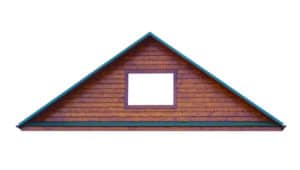If you are building a new home or replacing your roofing system, the variance of roof pitch may come up as an option. So, what is a roof pitch, exactly? When describing a roof, the pitch is the sloping degree or angle of its steepness. The pitch is in a ratio explaining how much of an angle the roof takes vertically for every 12 inches. This measurement is often displayed as the rise:run.
For example, a roof pitch of 8:12 describes a structure that climbs 8 inches for every 12 inches. The pitch can vary depending on the materials, the roofing design, and the local climate. Consequently, there is a minimum roof pitch for shingles, making this roofing choice available for specific situations.
Common Roof Pitch Measurements
A roof pitch can vary from a minimal 1/4:12 up to 12:12, providing a wide range of angles to use on a building. However, these extremes are not typical for traditional homes and are only suitable for specific situations. The common roof pitch measurements you find on most houses will fall between 4:12 and 9:12 to accommodate many standard roofing materials. So, what is the minimum roof pitch for shingles?
For example, a shingled roof is one of the more popular roofing choices and is not acceptable for roofing materials when the slope is 2:12 or less. Asphalt shingles are not designed to sit in water. Instead, they help protect the home and direct water down and away from the house.
Although the minimum roof pitch for shingles installation is only 2:12, these situations require specific shingles and a unique installation method to ensure they are water-resistant. Therefore, the National Roofing Contractors Association (NRCA) recommends that shingles should only be on roofs where the pitch is at 3:12 or higher. While this measurement is acceptable for many manufacturers’ shingles, homeowners typically use this material on roof pitches starting at 4:12.
How to Accurately Calculate Roof Pitch
Most individuals will not know their roof’s pitch measurement or how to calculate roof pitch unless they work in the construction industry. Thankfully, it isn’t hard to figure out what is a roof pitch on a home, even if you have no previous experience with roofing. You can calculate roof pitch in several ways, including digital apps or manual calculations.
Roof Pitch Calculator
One newer way to calculate roof pitch is to use a roof pitch calculator. Technology allows anyone to download a digital app to their mobile phone for iOS or Android that will quickly measure a roof pitch. However, this method is only sometimes accurate and can have discrepancies if you use one that requires photos.
Manual Calculations
Alternatively, manually measuring to calculate roof pitch will give accurate and immediate results. This method can include going outside to the roof’s surface or measuring inside at the rafters in the attic. But, of course, inside is a much safer and easier option. To figure out your roof’s pitch from your attic, you need a level, tape measure, pencil, and piece of paper.
- First, place the tape measure at the bottom of a rafter and extend it up to 12 inches, then mark it with a pencil. This is the run measurement.
- Next, place the level horizontally away from the corner of the rafter where you began the measurement. Ensure it is completely level before the next step.
- Then, use the tape measure to see the distance between the pencil mark on the rafter straight down to the level. This number is the rise measurement.
- Finally, you have the rise:run (12 inches) that you can identify to calculate roof pitch
How a Roof Pitch Can Affect Roof Replacements
What is a roof pitch’s effect on a total replacement? It may not seem important to the average homeowner, but the existing roof pitch will affect a roof’s replacement. This situation often arises when homeowners want to know the minimum roof pitch for shingles during roof replacements. Naturally, the steeper the pitch is, the more safety equipment a roofing contractor will need to complete this task. It will also take professionals longer to finish a roof replacement that has a higher pitch.
Consequently, if you want to change the roof pitch during your next roof replacement, it isn’t a simple job. Adjusting for a different pitch requires an entirely new roofing support system to accommodate it safely. Although it is possible to change it, many homeowners will not alter it once it’s in a home.
How an Improper Roof Pitch Can Affect the Life of a Roof
What is a roof pitch problem homeowners experience? An improper roof pitch can alter how long the roofing materials last and how well it protects your home. For example, it’s beneficial to have a steeper roof pitch in locations with snow and hail so debris will easily fall off. Conversely, low roof pitches are not ideal for this type of environment, where snow, hail, and water can collect on a roof surface and cause long-term damage.
Let Perfect Exteriors Handle Your Roofing Needs

A roof pitch is an essential element of your home’s roofing system. Knowing what pitch measurement is best for your home will ensure that it is durable and lasts through any weather. So, contact Perfect Exteriors today if you need to speak with a roofing expert about your existing roof pitch or any other roofing concerns.



